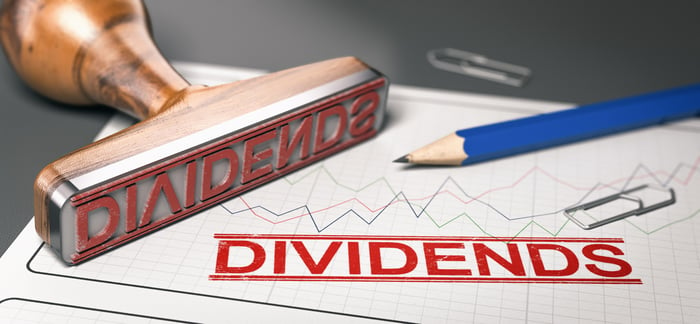At a base level, a stock is a claim on the long-term cash flows of a company, with dividends being a cash return on that claim. If you are a dividend investor trying to live off of the income you generate from your portfolio, you'll want to make sure your "claim" on cash flows is backed by a very strong company. Here's why you need to think past the most common dividend quality metric and consider dividends with a more holistic approach.
The payout ratio
When dividend investors start out, the first thing they are likely to learn about is the payout ratio. It is an important measure of dividend safety, but it has some problems. For starters, the math behind the payout ratio is to take the most recent dividend, annualize it, and then divide that number by earnings. Lower numbers suggest safer dividends, while a number over 100% suggests a dividend that could be at risk, since earnings aren't enough to cover the dividend. Always check out the payout ratio.

Image source: Getty Images.
And yet you need to look beyond this metric, too, because dividends don't come out of earnings. They come out of cash flow. Moreover, earnings can be highly volatile depending on the industry a company is in and the one-time charges, some of which may not have a cash impact on the company, that can distort earnings figures over short periods of time. A great example here is ExxonMobil (XOM 0.02%), which operates in the highly cyclical energy industry.
In 2020 Exxon lost $0.33 per share, so earnings didn't even come close to paying its $3.48 per-share dividend that year. But the company has managed to increase its annual dividend for four decades (and counting). Obviously there's more to the dividend story, and payout ratio alone isn't enough to capture it.
Commitment
A company's board of directors decides whether or not, and at what level, a dividend gets paid. There's no way to know what a board will decide, but companies like Exxon that have a long history of annual dividend increases have proven over time that a board often believes dividends are an important way to return value to shareholders. Dividend investors should probably prefer companies that have increased their dividends annually for 10 years. Better yet would be 25 years. And then there's a rarefied group of companies that have done so for 50 years or more, known as Dividend Kings.
Having a long streak of dividend hikes is not a guarantee that the streak will continue, but a strong dividend history does provide some insight into a corporate board's thinking. Very few boards want to cut a dividend because the stock price will likely fall as a result. So dividend increases provide a signal that the board, and company management, believe the company's long-term prospects are strong. A commitment to the dividend, meanwhile, is what will allow the payment to survive the inevitable hard times that all companies eventually face.
A foundation
Which brings the story to what may be the most overlooked factor in dividend safety, a strong balance sheet. Dividends come out of cash flow, which is supported by earnings. But cash flow doesn't only come from earnings; it also comes from financing efforts, like issuing debt. Exxon's terrible results in 2020 are a great example.
That year was impacted by global efforts to slow the spread of the coronavirus pandemic, which led to a reduction in energy demand and, thus, falling energy prices. Exxon entered the year with a debt-to-equity ratio of around 0.25. That's actually fairly low for any company. However, by the end of the year the company's debt-to-equity ratio had increased to just over 0.40; still a pretty reasonable number, but clearly much higher. While the integrated energy giant's earnings were under pressure, it used debt to support its business and dividend payments. Earnings have since bounced back -- not shocking given the cyclical nature of the energy patch, and the company has reduced leverage back to pre-pandemic levels.
XOM Debt to Equity Ratio data by YCharts
If Exxon didn't have such a strong financial foundation, it may not have been able to keep paying the dividend. A quick shorthand to check a company's financial strength is to see if it has an investment-grade rating, though it never hurts to dig in a bit deeper (examining things like the debt-to-equity ratio).
The final dividend call
A company isn't going to pay a dividend it can't support over the long term. So if you want to collect safe dividends, you'll want to own safe companies. A first line of defense is to look at the payout ratio, but don't get overly reliant on this figure. A low number is good, but a high one isn't always bad. Equally important will be examining a company's commitment to paying the dividend over time and its financial strength, which is the ultimate determinant of safety.
In the end, the payout ratio will likely fluctuate a lot more than a company's commitment to paying a dividend, or its balance sheet strength. And those last two are the factors that all safe dividend stocks have in common.






